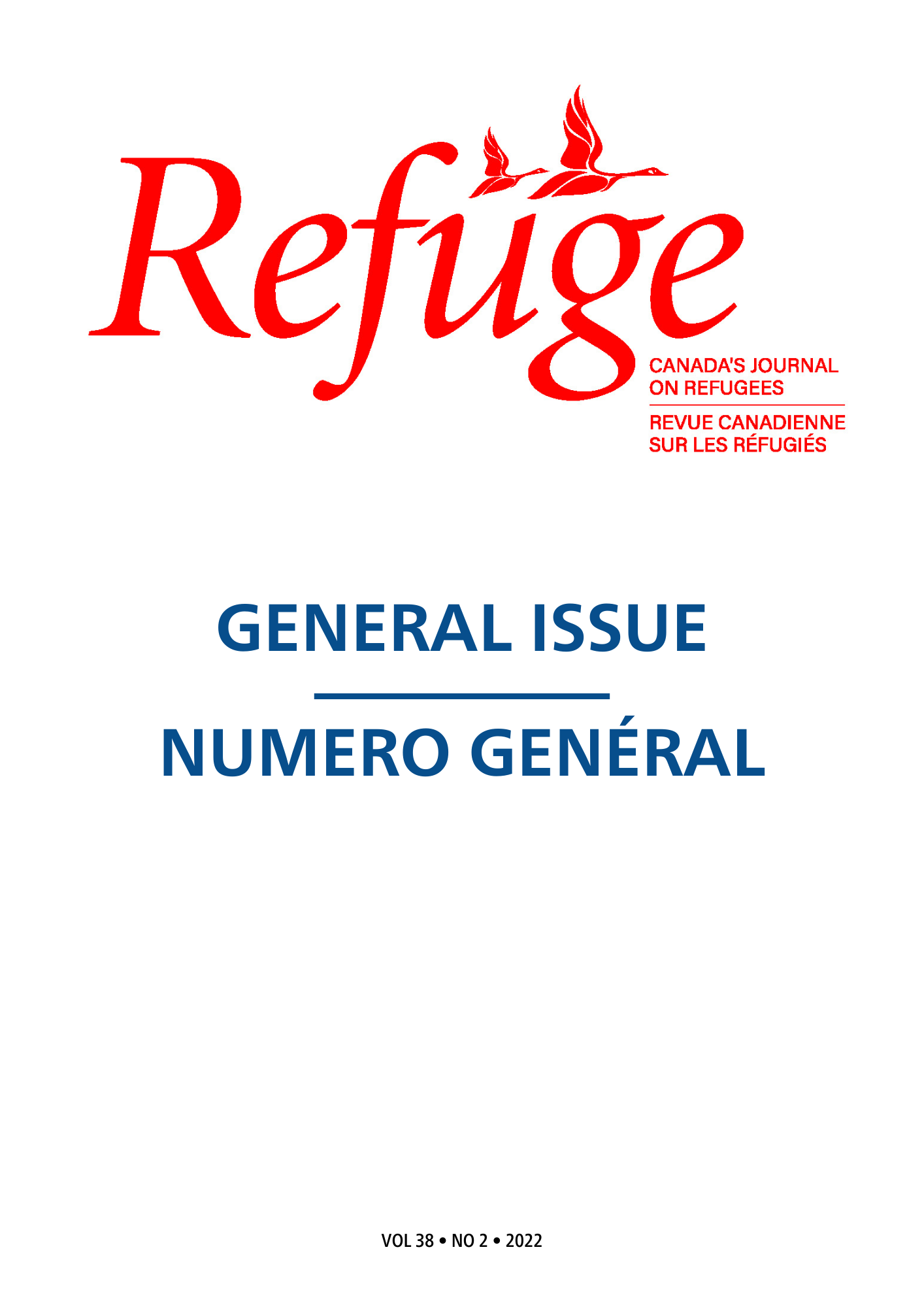Syrian Refugees’ Participation in Language Classes: Motivators and Barriers
DOI :
https://doi.org/10.25071/1920-7336.40799Mots-clés :
refugees, language, integration, Syria, resettlement, literacyRésumé
L'alphabétisation dans la langue du pays d’accueil facilite l'intégration et réduit la marginalisation sociale et économique. Ainsi, l'accès à l'apprentissage de la langue est une question de justice sociale. Les réfugiés réinstallés au Canada sont admissibles à une formation gratuite en anglais/français. Entre 2015 et 2017, le Canada a réinstallé 47 735 réfugiés syriens. Nous avons exploré les prédicteurs de la participation aux cours de langue pour les réfugiés syriens, en examinant les données de 1 915 réfugiés syriens adultes dans des cours de langue financés par le gouvernement en Colombie-Britannique, en Ontario et au Québec. Les facteurs entravant la participation variaient selon la province et comprenaient le sexe, la santé physique/mentale, l'éducation, l'alphabétisation en anglais/français et l'emploi. Des recommandations pratiques et politiques sont discutées.
Statistiques
Références
Alhussain, A. M. (2019). An empowerment tool for teaching English effectively to refugees: A case study of Syrian adult refugees in the UK. International Journal of English Linguistics, 9(1), 389–406. https://doi.org/10.5539/ijel.v9n1p389
Amrhein, V., Trafimow, D., & Greenland, S. (2019). Inferential statistics as descriptive statistics: There is no replication crisis if we don’t expect replication. American Statistician, 73(S1), S262–S270. https://doi.org/10.1080/00031305.2018.1543137
Bhalla, A., & Lapeyre, F. (1997). Social exclusion: Towards an analytical and operational framework. Development and Change, 28(3), 413–433. https://doi.org/10.1111/1467-7660.00049
Boyd, M., & Cao, X. (2009). Immigrant language proficiency, earnings, and language policies. Canadian Studies in Population, 36(1–2), 63–86. https://doi.org/10.25336/P6NP62
Casimiro, S., Hancock, P., & Northcote, J. (2007). Isolation and insecurity: Resettlement issues among Muslim refugee women in Perth, Western Australia. Australian Journal of Social Issues,42(1), 55–69. https://doi.org/10.1002/j.1839-4655.2007.tb00039.x
Choudhry, U. K. (2001). Uprooting and resettlement experiences of South Asian immigrant women. Western Journal of Nursing Research, 23(4), 376–393. https://doi.org/10.1177/019394590102300405
Ertorer, S. E. (2016). Acculturating into the Canadian society: A case of Karen refugees. Journal of Ethnic and Migration Studies, 42(11), 1864–1884. https://doi.org/10.1080/1369183X.2015.1128809
Farrugia, R. (2009). Integration at what cost? Research into what refugees have to say about the integration process. International Journal on Multicultural Societies, 11(1), 51–74. http://www.unesco.org/shs/ijms/vol11/issue1/art3
Finn, H. B. (2010). Overcoming barriers: Adult refugee trauma survivors in a learning community. TESOL Quarterly, 44(3), 586–596. http://www.jstor.org/stable/27896747
Gordon, D. (2011). Trauma and second language learning among Laotian refugees. Journal of Southeast Asian American Education and Advancement, 6(1), Article 13. https://doi.org/10.7771/2153-8999.1029
Government of the USA. (2018). UNHCR resettlement handbook: Country chapter—United States of America. UNHCR. https://www.unhcr.org/protection/resettlement/3c5e5a764/unhcr-resettlement-handbook-country-chapter-united-states-america.html
Grzymala-Kazlowska, A., & Phillimore, J. (2018). Introduction: Rethinking integration. New perspectives on adaptation and settlement in the era of super-diversity. Journal of Ethnic and Migration Studies, 44(2), 179–196. https://doi.org/10.1080/1369183X.2017.1341706
Hauck, F. R., Lo, E., Maxwell, A., & Reynolds, P. P. (2014). Factors influencing the acculturation of Burmese, Bhutanese, and Iraqi refugees into American society: Cross-cultural comparisons. Journal of Immigrant & Refugee Studies, 12(3), 331–352. https://doi.org/10.1080/15562948.2013.848007
Holm, A., & Dodd, B. (1996). The effect of first written language on the acquisition of English literacy. Cognition, 59(2), 119–147. https://doi.org/10.1016/0010-0277(95)00691-5
Hynie, M. (2018). Refugee integration: Research and policy. Peace and Conflict: Journal of Peace Psychology, 24(3), 265–276. https://doi.org/10.1037/pac0000326
Hynie, M., Korn, A., & Tao, D. (2016). Social context and social integration for government assisted refugees in Ontario, Canada. In M. Poteet & S. Nourpanah (Eds.), After the flight: The dynamics of refugee settlement and integration (pp. 183–227). Cambridge Scholars.
Hynie, M., McGrath, S., Bridekirk, J., Oda, A., Ives, N., Hyndman, J., Arya, N., Shakya, Y. B., Hanley, J., & McKenzie, K. (2019). What role does type of sponsorship play in early integration outcomes? Syrian refugees resettled in six Canadian cities. Refuge: Canada’s Journal on Refugees, 35(2), 36–52. https://doi.org/10.7202/1064818ar
Immigration, Refugees and Citizenship Canada. (2016, December). Rapid impact evaluation of the Syrian refugee initiative. http://www.cic.gc.ca/english/resources/evaluation/pdf/evaluation-syrian-refugee-initiative.pdf
Immigration, Refugees and Citizenship Canada. (2017a, November). Evaluation of the settlement program. https://www.canada.ca/en/immigration-refugees-citizenship/corporate/reports-statistics/evaluations/settlement-program.html
Immigration, Refugees and Citizenship Canada. (2017b). Syrian refugees—Monthly IRCC updates [Open source data]. http://open.canada.ca/data/en/dataset/01c85d28-2a81-4295-9c06-4af792a7c209
Immigration, Refugees and Citizenship Canada. (2019, June). Syrian outcomes report. https://www.canada.ca/en/immigration-refugees-citizenship/corporate/reports-statistics/evaluations/syrian-outcomes-report-2019.html
Ives, N., Denov, M., & Sussman, T. (2020). Introduction to social work in Canada: Histories, contexts, and practices (2nd ed.). Oxford University Press.
Ives, N., & Sinha, J. W. (2010). The religious congregation as community partner in refugee resettlement: An overview of theory and practice for social workers. Canadian Social Work, 12(1), 210–217.
Morrice, L., Tip, L. K., Collyer, M., & Brown, R. (2021). “You can’t have a good integration when you don’t have a good communication”: English-language learning among resettled refugees in England. Journal of Refugee Studies, 34(1), 681–699. https://doi.org/10.1093/jrs/fez023
Nawyn, S. J., Gjokaj, L., Agbényiga, D. L., & Grace, B. (2012). Linguistic isolation, social capital, and immigrant belonging. Journal of Contemporary Ethnography, 41(3), 255–282. https://doi.org/10.1177/0891241611433623
Okyay, A. S. (2017). Labour market integration of Syrian refugees in Germany and Turkey: Challenges and prospects (Global Turkey in Europe working paper 18). https://www.iai.it/sites/default/files/gte_wp_18.pdf
Phillimore, J. (2021). Refugee–integration–opportunity structures: Shifting the focus from refugees to context. Journal of Refugee Studies, 34(2), 1946–1966. https://doi.org/10.1093/jrs/feaa012
Statistics Canada. (2022). Population estimates, July 1, by census metropolitan area and census agglomeration boundaries, 2016. https://www150.statcan.gc.ca/t1/tbl1/en/tv.action?pid=1710013501
Strang, A., & Ager, A. (2010). Refugee integration: Emerging trends and remaining agendas. Journal of Refugee Studies, 23(4), 589–607. https://doi.org/10.1093/jrs/feq046
Tadayon, F., & Khodi, A. (2017). Empowerment of refugees by language: Can ESL learners affect the target culture? TESL Canada Journal, 33(10), 129–137. https://doi.org/10.18806/tesl.v33i0.1250
Tip, L. K., Brown, R., Morrice, L., Collyer, M., & Easterbrook, M. J. (2019). Improving refugee well-being with better language skills and more intergroup contact. Social Psychology and Personality Sciences, 10(2), 144–151. https://doi.org/10.1177/1948550617752062
Valenta, M., & Bunar, N. (2010). State assisted integration: Refugee integration policies in Scandinavian welfare states: The Swedish and Norwegian experience. Journal of Refugee Studies, 23(4), 463–483. https://doi.org/10.1093/jrs/feq028
Valtonen, K. (2008). Social work and migration: Immigration and refugee settlement and integration. Routledge. https://doi.org/10.4324/9781315609669
Wilkinson, L., & Garcea, J. (2017). The economic integration of refugees in Canada: A mixed record? Migration Policy Institute. https://www.migrationpolicy.org/sites/default/files/publications/TCM-Asylum_Canada-FINAL.pdf
Téléchargements
Publié-e
Comment citer
Numéro
Rubrique
Licence
© Nicole Ives, Anna Oda, Jonathan Bridekirk, Michaela Hynie, Susan McGrath, Rana Mohammad, Mona Awwad, Kathy Sherrell, Mahi Khalaf, Marcela Diaz 2022

Cette œuvre est sous licence Creative Commons Attribution - Pas d'Utilisation Commerciale 4.0 International.
Les auteurs qui publient dans Refuge conservent le droit d’auteur associé à leur œuvre, et octroient au public une licence Creative Commons Attribution - Utilisation non commerciale 4.0 International. La licence permet l’utilisation, la reproduction et l’adaptation du matériel avec attribution par tous moyens et sous tous formats pour des fins non commerciales. Pour des informations générales sur les licences Creative Commons, visitez le site Creative Commons. Pour la licence CC BY-NC 4.0, consultez le résumé lisible par l'homme.







